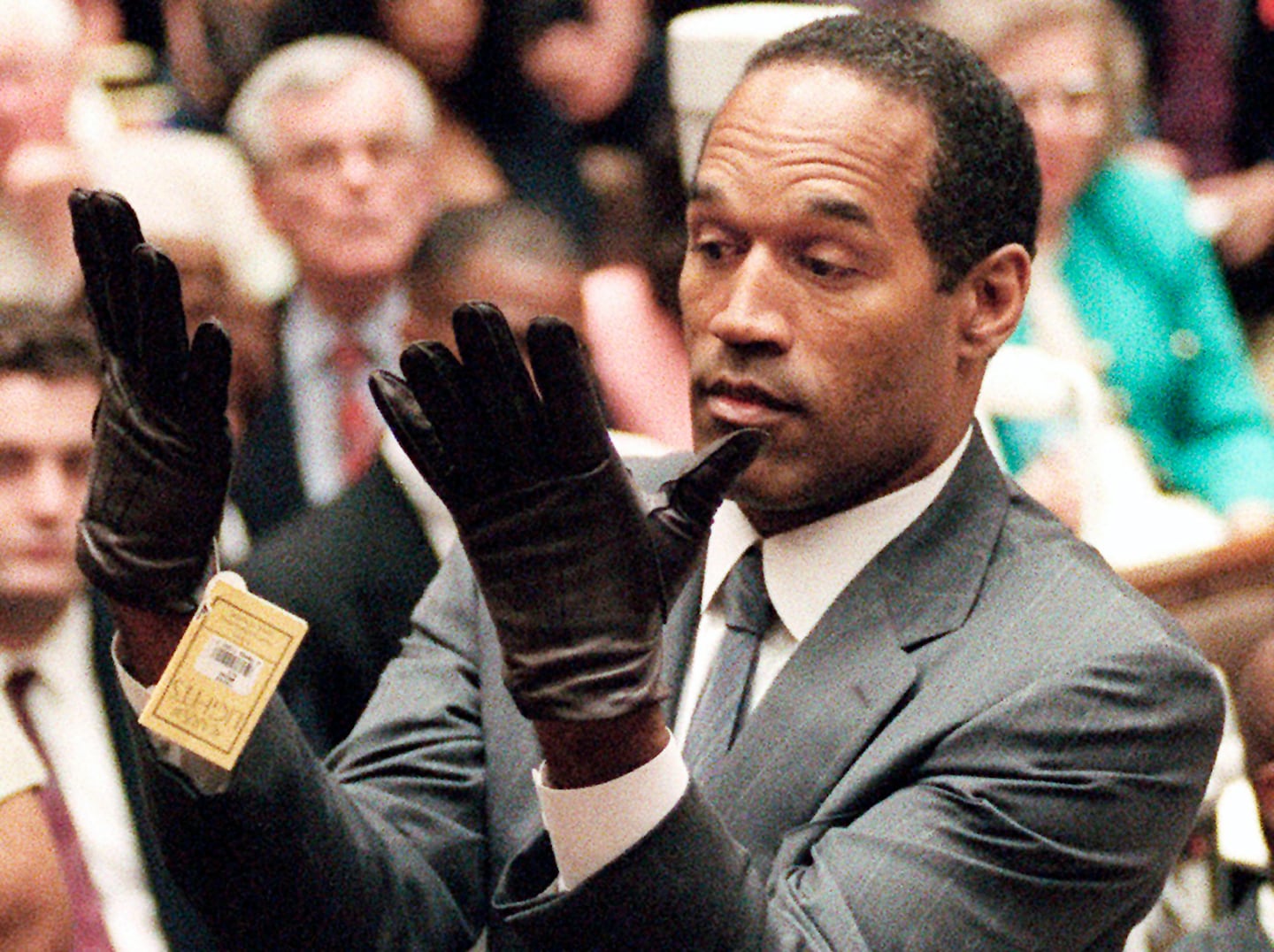“White, black, immigrants who were from different races, women and men, rich and poor — and everyone was glued to the television,” said Charles Ogletree, a professor at Harvard Law School who directs the school’s Institute for Race and Justice.
Twenty years ago this Thursday, Simpson’s ex-wife, Nicole Brown Simpson, and a friend, Ronald Goldman, were found stabbed to death in the Brentwood area of Los Angeles. Simpson, a famous actor, running back and Heisman Trophy winner who was one of the most recognizable personalities in the country, was implicated in the killings and would soon be charged with double murder.
What came next — the slow-speed white Bronco chase, round-the-clock television coverage, a riveting trial and not-guilty verdict that split the country along racial lines — offered the United States a gateway drug its residents eventually couldn’t live without.
“What I realized is, this is entertainment,” said Gerald Uelmen, one of Simpson’s defense attorneys. “This is not news.”
O.J. Simpson criminal trial timeline
The “trial of the century” captivated the nation as the former football star was accused of murdering his ex-wife and her friend.
In the years since, the lineage of so many cultural phenomena — the 24-hour news cycle, a never-ending stream of reality television shows and many Americans’ unquenchable thirst for celebrity gossip — can be traced to this nearly 16-month span.
Before the killings on June 12, 1994, CNN was 14 years old and had a foothold in households but wasn’t yet appointment viewing; Court TV was a startup network with a niche of drawing legal die-hards into courtrooms. Fox News and MSNBC were two years from their cable debuts. Prime-time programming in those days consisted of scripted entertainment; no one then could imagine that, two decades into the future, televising the trivialities of daily life would captivate the public.
Simpson was one of the most marketable ex-athletes in the country. One of the greatest running backs of all time, Simpson built a successful post-playing days career as an actor and a pitchman. He was an African American who transcended race and became known for his upbeat, everyman smile as he jogged through the airport, leaping over suitcases in Hertz rental car commercials.
But soon after the killings, the landscape began changing. Players in the Simpson drama, large and small, quickly became international celebrities, millions glued themselves to televisions for the case’s next twist, and TV producers and sports agents began preparing for a country whose trust in the criminal justice system and professional athletes had taken a direct hit. As for Simpson, he would be acquitted in October 1995, a verdict that split the nation, before losing a civil jury trial that ordered him to pay $33.5 million to the families of Nicole Brown Simpson and Goldman, who were both white. Simpson, now 66, is currently serving prison time on a 2008 armed robbery conviction.
“It made a lot of things look pretty rotten, made things look pretty raw,” said Greta Van Susteren, a former adjunct law professor at Georgetown University who became a star for her legal analysis on CNN during the Simpson proceedings and now hosts a nightly show on Fox News.
But amid all the grime, if the proliferation of reality shows, the tabloidization of the media and the insatiable appetite for celebrity news can be called that, some good was done, too. Inspired by the use of DNA evidence during the Simpson trial, more than 300 wrongfully convicted inmates rode the relatively new science to freedom.
“There will never be another case that has the combination of circumstances, facts and timing that allowed this case to explode,” television commentator Dan Abrams said.
Abrams was 28 when the assignment came: Get to Los Angeles to cover the Simpson case.
He was the junior correspondent for Court TV, and he drew the job only because the network’s two other field reporters were busy. A few months later, before the trial began, he opened People magazine to read that he was listed among the “Who’s who” in the Simpson case, alongside prosecutor Marcia Clark, judge Lance Ito and Brian “Kato” Kaelin, a little-known actor who lived on the Simpson property and became a prosecution witness and media darling.
“As more and more people were watching,” said Abrams, now a co-anchor on ABC’s “Nightline,” “it became clear this was different.”
Court TV and CNN had made the bold decision to cover every turn of the case, no matter how meaningless. Back then, this was revolutionary and maybe even a little risky; never had one news event been covered so continually. But rather than recoil, TV viewers barely noticed they were ignoring their soap operas and prime-time dramas because this one beat them all. Here was a celebrity on trial for murder — with race and sex providing colorful sidebars — with a cast of newly familiar faces as its central characters. Suddenly the decision to carry the case around the clock seemed brilliant; in the days before live streams, constantly updated Web sites and social media, the two channels were feeding a national hunger.
The Simpson case was a “harbinger of an entirely different media landscape — an event that preoccupies everyone full-time for months on end,” said Mark Crispin Miller, a professor at New York University who studies media and culture. “You have to become gradually acclimated to this kind of spectacle.”
After the Simpson verdict, when public interest in trial coverage eventually weakened, Court TV rebranded itself in 2008 as TruTV, which broadcasts something called “actuality” television. The major broadcast and cable networks, meanwhile, turned to unscripted contest shows and programs featuring the adventures of families with 17 or more children, friends living together along the New Jersey coast, and the mostly bearded family of a duck-call company in Louisiana.
“Fifty years ago, what you would’ve turned away from as outrageous, you turn to as kind of normal and interesting,” Miller said. “And then you can’t do without it.”
After Simpson’s criminal case closed, many key players in the drama moved on to even bigger stardom. A few, including Uelmen and Clark, wrote books. Van Susteren began co-hosting a nightly legal analysis program. Harvey Levin, who had covered the trial for a Los Angeles news station, appeared on reality shows and eventually founded the celebrity Web site TMZ.
Sports agent Leigh Steinberg, who represented many of the 1990s’ biggest names, adjusted his marketing strategy to convince companies that Simpson was an aberration; that an endorsement from a famous athlete was still solid. But even Steinberg couldn’t sell a client with a history of domestic violence. “Advertisers were not looking for players who reminded them of the Simpson situation,” Steinberg said.
Trust in athletes took years to rebuild, Steinberg said, and even now, major incidents such as those involving football players Michael Vick and Aaron Hernandez in recent years are setbacks. Athletes are now more closely vetted by sponsors and their own teams.
“In the viewers’ mind’s eye, this was not an isolated event,” Steinberg said of the Simpson case. “One event has the psychological impact of a thousand events.”
The case, and in particular the not-guilty verdict, also fanned leftover racial tension from the 1991 police beating of Rodney King, which triggered race riots in Los Angeles. Race had been a key topic during the trial — a black defendant, two white victims, Los Angeles detective Mark Fuhrman’s use of a racial slur (a revelation Simpson’s lawyers used to question his motives), even the jury’s racial diversity (nine blacks, two whites and a Hispanic).
Its conclusion quieted little of the talk that America remained divided; opinions on the case and verdict traveled racial lines, and two decades later, they often still do.
“When you ask people today, African Americans will overwhelmingly say that, not that he’s not guilty, but the government didn’t prove that he was guilty,” said Ogletree, the Harvard law professor. “White people will say that he killed two white people and got away with it.”
Some who followed the case were watching for more than just entertainment. The proceedings were shown on televisions in prison day rooms and inside cells, where hundreds saw an opportunity.
Two members of Simpson’s defense team, Barry Scheck and Peter Neufeld, had earlier founded the Innocence Project, a nonprofit that assigned law students to use DNA evidence to free wrongfully convicted inmates. Before the trial, this relatively new science was seen as confusing and expensive; the Simpson trial demonstrated it could be available to everyone.
“DNA was so complex and complicated that nobody really asked for it,” Van Susteren said. “They might find some man or woman, usually man, sitting in some country jail someplace in the middle of some state, and all of a sudden after watching O.J. Simpson — because the world did — he asks for a DNA test.”
One of those was Marvin Anderson, who at age 18 was convicted of a rape he didn’t commit. After a decade in prison and letters to politicians and talk-show hosts, a counselor suggested he contact Scheck and Neufeld. At that time, Anderson was one of a handful to pursue exoneration through DNA evidence. After the Simpson coverage, the entire country — along with its falsely accused and wrongfully convicted — knew of this new frontier.
“The O.J. Simpson trial made the world know about DNA,” said Anderson, now a 50-year-old volunteer firehouse captain in Hanover, Va. He was exonerated in 2002, two decades after the rape victim incorrectly identified him in a police lineup.
In total, the Innocence Project has helped to overturn 316 convictions, including some that led to death sentences. Without the awareness generated by the Simpson case, Van Susteren said, some might still be sitting in prisons or awaiting for their final punishments.
“I know there are a lot of warts and scars and everything else about what people say about the O.J. Simpson trial,” she said. “The fact that everybody knew about DNA is huge to our criminal justice system.”


 Best Underground Water Leak Detection Equipment 2024
Best Underground Water Leak Detection Equipment 2024  Best Backyard Ideas: Turn Your Outdoor Area Into a Creative and Calm Haven
Best Backyard Ideas: Turn Your Outdoor Area Into a Creative and Calm Haven  Babar, Rizwan are good players but not whole team, says Mohammad Hafeez
Babar, Rizwan are good players but not whole team, says Mohammad Hafeez  Pak vs NZ: Green Shirts aim to bounce back against Kiwis today
Pak vs NZ: Green Shirts aim to bounce back against Kiwis today